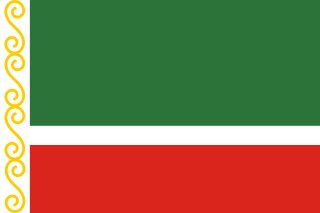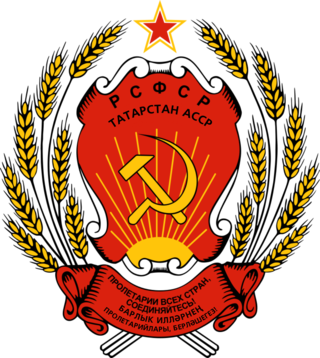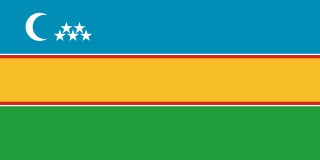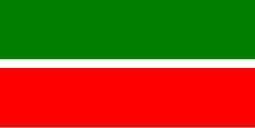
The penultimate USSR-era flag was adopted by the Russian Soviet Federative Socialist Republic (RSFSR) in 1954 and used until 1991. The flag of the Russian SFSR was a defacement of the flag of the USSR. The constitution stipulated:
The state flag of the Russian Soviet Federative Socialist Republic (SFSR) presents itself as a red, rectangular sheet with a light-blue stripe at the pole extending all the width [read height] which constitutes one eighth length of the flag.

The national flag of Azerbaijan, often referred to as the tricolour flag, is a horizontal tricolour that features three equally sized bars of bright blue, red, and green; a white crescent; and a centred eight-pointed star. The flag has become the predominant and most recognizable symbol of Azerbaijan. The bright blue represents Azerbaijan's Turkic identity, the red represents progress, and the green represents Islam, which is Azerbaijan's majority religion.

The flag of Chechnya is a rectangle with sides in the ratio 2:3 representing the Chechen Republic, a republic of Russia. The flag is composed of three horizontal bars of, from top to bottom: green, representing Islam; white; and red; superimposed on them is a narrow vertical white band at the hoist, containing the national ornament, a design of four golden scroll shapes.

The flag of Kazakhstan was adopted on 4 June 1992, replacing the Soviet-era flag. The flag was designed by Shaken Niyazbekov.

The flag of the Republic of Karelia is the official state symbol of the Republic of Karelia. Adopted by the Supreme Council of the Republic of Karelia on February 16, 1993. The flag was designed by Alexander Ivanovich Kinnear.

The flag of Udmurtia is one of the official state symbols of the Udmurt Republic, along with its emblem and anthem. The proportion of width and length of the flag is 1:2. It is a rectangular three-color cloth consisting of vertical equal stripes of black, white and red with an eight-pointed red cross. The black colour in the flag is a symbol of the earth and stability, red means the sun and life and white means a space and moral purity. The designer of the flag of the Udmurt Republic was Yuri Lobanov. The appropriate law N26-РЗ "On the National Flag of the Udmurt Republic" appeared on 30 April 2002.

The state flag of Ingushetia, a republic in the Russian Federation, is a horizontal tricolour that shows a red triskelion solar sign on a white background, with narrow green horizontal stripes above and below. The white symbolizes purity of thoughts and actions, the green—the awakening of nature, abundance, fertility of the land of Ingushetia, as well as Islam, which the Ingush profess, red—the difficult struggle of the Ingush people against injustice, for the right to live on the land of their ancestors in peace and harmony with neighboring peoples throughout centuries; the solar symbol symbolizes the endless development leading to the prosperity of the Ingush people.

The flag of the Chuvash Republic, a republic of the Russian Federation, is one of the official symbols of the Chuvash Republic, alongside the coat of arms and the state anthem. The flag is a 5:8 yellow flag with a stylized red tree of life charged on the flag. The flag has been used officially as the flag of the Chuvash Republic since 14 October 1992.

The state flag of the Sakha Republic (Yakutia) in Russia is one of the official symbols of the Sakha Republic, alongside the coat of arms and the national anthem of the Sakha Republic. The flag has four horizontal stripes. From top to bottom, the stripes are light blue, white (1/16), red (1/16), and green (1/8). The flag has been used officially as the flag of the Sakha Republic since 14 October 1992. The light blue stripe is charged with a white disc in the center. The diameter of the disc is 2/5 of the flag's width.

The flag of Crimea is the flag of the Autonomous Republic of Crimea in Ukraine and the Republic of Crimea controlled by Russia. The flag was officially adopted on 24 September 1992 as the flag of the Republic of Crimea, readopted on 21 April 1999, then readopted on 4 June 2014 as the flag of the Republic of Crimea, annexed by the Russian Federation.

The Flag of the Komi Republic in Russia is one of the official symbols of the federal subject, alongside the coat of arms and the State Anthem of the Komi Republic. The flag is a horizontal tricolour with 2:3 proportion. The flag was composed of three bars of, from top to bottom, medium blue, green, and white.

The flag of the Republic of Bashkortostan is one of the official state symbols of Bashkortostan, a federal subject of Russia, alongside the coat of arms and anthem. The flag has three horizontal stripes. From top to bottom, the stripes are teal blue, white, and green. The flag has been used officially as the flag of the Republic of Bashkortostan since 25 February 1992. The white stripe of the flag is charged with a kurai flower in the center.

The flag of Mari El, a federal subject and republic in the Russian Federation, was adopted by the Parliament of Mari El on 1 June 2011.

The national emblem of the Tatar Autonomous Soviet Socialist Republic was adopted in 1937 by the government of the Tatar Autonomous Soviet Socialist Republic. The emblem is identical to the emblem of the Russian Soviet Federative Socialist Republic.

The flag of the Chuvash Autonomous Soviet Socialist Republic was adopted in 1954 by the government of the Chuvash Autonomous Soviet Socialist Republic. The flag is identical to the flag of the Russian Soviet Federative Socialist Republic.

The flag of the Yakut Autonomous Soviet Socialist Republic was adopted in 1954 by the government of the Yakut Autonomous Soviet Socialist Republic. The flag is identical to the flag of the Russian Soviet Federative Socialist Republic.

The flag of the Kabardino-Balkarian Autonomous Soviet Socialist Republic was adopted in 1957 by the government of the Kabardino-Balkarian Autonomous Soviet Socialist Republic. The flag is identical to the flag of the Russian Soviet Federative Socialist Republic.

The flag of the North Ossetian Autonomous Soviet Socialist Republic was adopted in 1954 by the government of the North Ossetian Autonomous Soviet Socialist Republic. The flag is identical to the flag of the Russian Soviet Federative Socialist Republic.

The flag of the Udmurt Autonomous Soviet Socialist Republic was adopted in 1954 by the government of the Udmurt Autonomous Soviet Socialist Republic. The flag is identical to the flag of the Russian Soviet Federative Socialist Republic.

The state flag of Karakalpakstan is one of the official symbols of Karakalpakstan, an autonomous republic within Uzbekistan. It was designed from a sketch by Karakalpak artist Zhollybai Izentaev. The flag is based on the flag of Uzbekistan.































